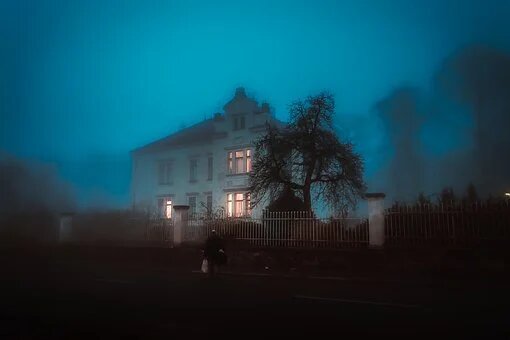
The Hollow of the Three Hills by Nathaniel Hawthorne is a story about a young woman who becomes overcome with grief and sadness and goes to a withered witch to learn what has happened to her family. The witch shows her three different visions of reality. In the first one, she sees her parents who are talking about how much disappointed they are in her. The second vision is of her husband who is seen weeping at her funeral. The third one shows her own son to her, who she sees has died and his coffin is being carried to his grave.
The Hollow of the Three Hills | Summary
The story is set in a long gone era, in the hollow between three hills, two people meet. One of them is a beautiful but troubled young woman who has fled from her home and who has been “smitten with an untimely blight in what should have been the fullest bloom of her years.” The second one is an ancient witch who is said to have lived more than any other human being. She is said to be a “meanly dressed” old crone. Though the hills are laden with greenery and full of trees, the place of the hollow is said to be having no sign of life and containing nothing but the dying brown grass of October, several decaying tree stumps and a stagnant green pond. The hollow’s eerie presence is said to be because it once used to be the home of a powerful evil that used to performed rituals there.
The witch asks the old woman to address her requests fast as she was in a hurry and they only have one hour. Seeing the witch, the young woman gets a little scared and thinks about running away but she finds her feet rooted to the spot and stands there instead. The young woman tells her story to the old crone. She tells her that she is new to the hollows but the place she has come from doesn’t matter because she is not going back there. She also tells that she has left her loved ones behind and is “cut off forever.” She is melancholic that she can’t go back to the place she has come from and she is worrying about her family and wants to see, perhaps for the last time, the well being of her family members.
The old crone mocks the woman and tells her that she does not have these answers ready for her. Nevertheless, the old crone assures her that she will tell her before the sun sets, the young woman instantly agrees for whatever the payment might be for such a task. The young woman is willing to die for one last glimpse of her family. The old woman then, sits on the trunk on a fallen tree and beckons the young woman closer. She asks the young woman to kneel and put her forehead on her lap. The woman gets anxious and hesitates but then realises that she has no other option and does as asked. The crone draper her cloak over the young woman’s head, she begins muttering a prayer. The prayer startles the young woman and she frantically thrashes and asks to go and never return back but after a moment she regain her calm composure and gets “still as death.” She realizes that there are other voices mingling with the crone’s prayer and she recognizes those voices. She continues to listen and the voices grow stronger- along with the sound of a ticking clock and a roaring fire- until in the end, she is able to hear a distinct scene.
The young woman sees two figures, one of a man and the other one a woman, who are sitting by the fireplace and they are speaking in hushed tones and sad voices about their daughter who has gone missing. They talk about how their daughter has brought dishonour upon their family and they would have to take this burden, on their head full of grey hair, to their graves. They continue to speak but their voices start mingling with the wind and fade away after some time. The old crone smiles and notes that the old couple appear to be going through a rough time. The young woman feels ‘humiliation and agony’ that the crone is also able to hear them. The old crone says that there is much left that they have to hear still. Again the crone drapes the cloak over the young woman; starts a prayer, the voices begin merging.
This time, the woman notices that the voices are a mixture of shrieks, sobs, screams and love songs along with funeral hymns. As the voices change, so does her mood. In the midst of the cacophony, the sober and solemn voice of a man was distinguishable, he was speaking in a frenzied tone, to anyone and everyone who listened, about his wife who has broken the most serious vows and left his home desolate and barren. He continued to speak and once again, all the voices merge with the wind, fading eventually.
The crone asks the woman if she wants to listen further and the woman says that there is one voice she would like to hear. The crone asks her to lay her head on her lap as she has done for the past times, the woman concedes and lays her head one more time. As the crone says the prayer, the woman hears the sound of a death bell. After some time, she hears the sound of footsteps and sees some people carrying a coffin led by a priest. The whispers are heard in the crown of a woman who has abandoned her family and betrayed the trust of her husband and left her child to die. The voices fade for the final time and when the crone tries to raise the woman’s head, the woman does not lift her head, the crone declares that her “sweet hour’s sport” is finished.
The Hollow of the Three Hills | Analysis
In the opening scene itself, the narrative immediately establishes the good and evil forces and differentiated the two, forcing the reader to look at the two main characters’ stark differences as the prime example of both. The story starts with an intriguing description of the hollow between the three hills. The hollow has an unusual aura of decay and mystery. Hawthorne creates a place which reflects the mystery and magic of the witch who uses the place as a meeting place.
Through the use of setting, language, and detailed description in the opening of the story, the author develops a theme of darkness, loss and shame. The reader imagines the whole story taking place in darkness, both literally and figuratively. This is intentional on the author’s part as it sets the tone for the story which is melancholic from the beginning to the very end. Hawthorne gives life to the hills and they seem like a supernatural environment to the narrative.
There is an aura of mystery throughout the story as the reader doesn’t know the reason the old woman has fled from her home. Through the course of the narrative, it is clear that she still cares for her family as she is willing to die to catch one last glimpse of her family members. From this, it is clear that she does not run away because she is forced to or because she is unhappy. The reader is left with many questions like- Why is she here? How does she find the witch? Why did she run from her home? Why can’t she go back?
None of these questions are answered and the reader feels disappointment about not knowing the story further.
The three hills are a representation of the three memories that the crone conjures up for the young woman. Each hill represents the painful memory that the woman sees. The young woman has left her family behind to disgrace. She has left her husband to fend for himself and he is left mourning for the separation as she has broken the most holy vows one can make.
Throughout the story, there is the mention of the fallen tree. This is a representation of the woman’s family that is left broken and tattered. While the story certainly doesn’t classify as a horror story, the setting, the tone and the atmosphere of the story is dark and mysterious that makes the reader think and ponder upon some questions.
The Hollow of the Three Hills | About the Author – Nathaniel Hawthorne
Nathaniel Hawthorne was an American novelist and short story writer. He was born in 1804 in Salem, Massachusetts to Nathaniel Hathorne and the former Elizabeth Clarke Manning. He entered Bowdoin College in 1821 and graduated in 1825. His first published novel is ‘Fanshawe’ in 1828. He published various short stories in various periods which he later titled as Twice Told Tales in 1837.




